|
| Front page | | Contents | | Previous | | Next |
Nature & Environment 2003 – Theme: Water in Denmark
Watercourses and lakes
Conditions for lakes and watercourses have been difficult for many years. Draining has significantly reduced them in number, and additions of wastewater have led to poor
water quality. However, these developments have now been reversed. More lakes are being re-established and efforts to reduce additions of nutrients have born fruit so that
transparency is now increasing.
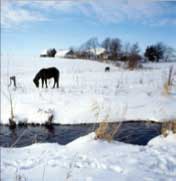
The Danish landscape is criss-crossed by 35,000 kilometres of natural watercourses and 25,000 kilometres of artificial ditches and channels. Development, and especially agricultural
development, has meant that watercourses have been changed significantly. In order to dry out fields, extensive drainage has been carried out, and many watercourses have been
changed, straightened, or dug into pipes. Draining is promoted through cutting green crops and in some places dredging sand from watercourses. These actions have led to much poorer
habitats for animals and plant life in 90 per cent of the natural watercourses. The condition of watercourses has been made even worse by discharges of wastewater and xenobiotic
substances.
More lakes
Lakes are important for recreation and for nature. There are approximately 120,000 lakes larger than 100 m2 in Denmark, most of these ponds and marshes, with only about 2,500
larger than 1 hectare. For many years, the number of lakes has been falling as a result of agricultural and urban development. However, this trend has now been reversed as the
Protection of Nature Act now also covers smaller lakes. Furthermore, a number of lakes that previously had been drained have now been re-established.
Water quality now improving
For many years the water quality in lakes has been very poor. This is due to large additions of the nutrients phosphorus and nitrogen, not least from urban wastewater. Large investments
in reducing additions of nutrients have, however, born fruit and the water quality in watercourses and lakes is improving. Transparency illustrates the amount of plant plankton (algae or
phytoplankton) and thus nutrients in water; and transparency is increasing, indicating a decrease in the amount of plant plankton.
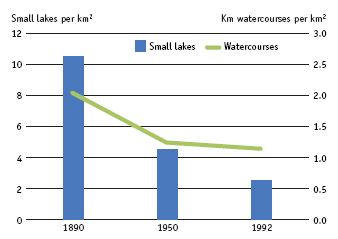
Many small lakes and watercourses have disappeared from the landscape as a result of draining. The bar chart shows the trend in the area around Arreskovsø on
Funen.
Source: County of Funen
Over the past 100 years, the extent of open watercourses on Funen has fallen dramatically because digging ditches and watercourses into pipes, and straightening watercourses, has
made them shorter. For example, on the basis of old maps it has been calculated that the length of the watercourses in the catchment area for Hundstrup Å, a river in southern Funen, fell
from about 174 kilometres in 1890 to about 97 kilometres in 1992.
Draining of wetlands, etc. for cultivation has also had a great impact on the number and size of lakes and fjords on Funen. In the catchment area for Arreskovsø, a lake, the number of
smaller lakes and waterholes has fallen from 276 to 65 over the past 100 years. This development has dramatically reduced the habitats for animals and plants.
Looking at Denmark as a whole, today about 80 per cent of the total land area is affected by drainage, and only 4 per cent is covered by marshes, bogs, and water meadows. The
natural interplay between watercourses and meadows, with periodical flooding of watercourses to fertilise meadows, only occurs in very few places in Denmark. The 1992 Protection of
Nature Act has put a stop to direct drainage of small lakes and marshes, and now it is only possible to water fields with water extracted from the groundwater.
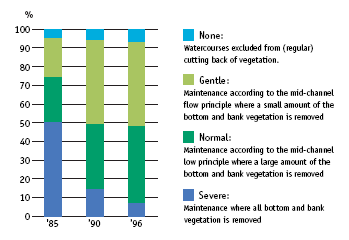
Since 1982, environmental concerns have been incorporated in the maintenance of public watercourses. In 1985, both bottom and bank vegetation was removed from
half of the public watercourses. In 1996, only 7 per cent of watercourses were maintained in this way, whereas vegetation in more than half of the watercourses was
maintained more carefully, or through cutting back vegetation.
Gentler maintenance of watercourses provides more space for plant and animal life.
Source: National Environmental
Research Institute
In 1982, the Watercourse Act was amended in order to include environmental interests. This meant the preparation of new provisions for management and maintenance of watercourses
looked after by the public sector. Cutting back vegetation, for example, was not to be as extensive as previously, where all plant growth was removed at least once a year. The
provisions have been laid down in regulations.
Improvements are now primarily taking place in small watercourses, as environmental maintenance for the larger watercourses (county watercourses) had typically already made its
mark before 1990. Changes to more gentle maintenance in municipal watercourses (smaller watercourses) mostly occurred somewhat later.
In watercourses on Funen, 17 per cent of watercourses are maintained by the county, 28 per cent by municipalities, and the remainder (private watercourses) by landowners. In
general, county watercourses are the largest watercourses. In 2000, only two of the 32 municipalities on Funen had not adopted new and more environmentally friendly watercourse
regulations. The new maintenance approach for county watercourses has led to changes in both plant growth and animal life. There are now at least four times more trout, partly because
there is better cover in which they can hide.
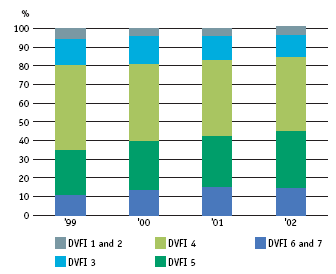
The figure shows the biological quality of watercourses in
Denmark for the period 1999- 2002. The dark-blue and dark-green illustrate clean and physically varied watercourses (fauna classes 5, 6, and 7). From 1999-2002
there was a clear improvement with an increasing number of clean and physically varied watercourses.
Source: National Environmental
Research Institute
Since 1999, the same network of stations in more than 1000 locations has been used to measure the Danish watercourse fauna index (DVFI). From 1999-2002 there was a clear
improvement with an increasing number of clean and physically varied watercourses – fauna classes 5, 6, and 7. The proportion of watercourses unaffected, or only slightly affected,
increased from just less than 35 per cent to more than 44 per cent in the period.
The improvement in the biological quality of watercourses in the period 1999-2002 has meant that the number of targets in the national plan being met has increased from 39 per cent to
50 per cent. The improvements have been gradual and they have happened over the whole period. Improvements have also been throughout Denmark. In Jutland and on Funen the
number of targets met increased from 43 per cent to 55 per cent, while on Sealand, Lolland and Falster the figure has improved from 27 per cent to 34 per cent. Improvements in the
biological quality of watercourses are probably due to a combination of better water quality and improved physical conditions in watercourses.
Animal life only reacts gradually to the better living conditions in watercourses, and in many cases it may take a long time before animals return to previously polluted stretches of
watercourses. The explanations for much of the improvement in the fauna class in recent years should undoubtedly take account of the environmental initiatives carried out by
municipalities and counties over many years.
These efforts will be maintained in the future as the Government's Pesticide Plan for 2004-2009 designates 25,000 hectares of spray-free buffer zones along watercourses.

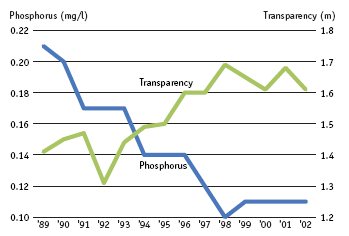
The phosphorus content in
Danish lakes was almost halved in the 1990s. In recent years, this has made the water in lakes clearer and increased transparency. The environmental state of 70 per
cent of Danish lakes remains, however, poor.
Source: National Environmental
Research Institute
This indicator shows the trend in concentrations of phosphorus and transparency in 27 Danish freshwater lakes for the period 1989-2002. The concentration of phosphorus is stated as
the annual mean value of total phosphorus in mg/l and transparency is stated as the summer average in metres.
Phosphorus is the nutrient that most affects Danish lakes. Total discharges of phosphorus from 1989 to 2002 fell by two- thirds, and in the same period the concentration of phosphorus
in Danish lakes was almost halved. When a lake is over-fertilised with phosphorus, production of plankton increases and the water loses clarity. The drop in the content of phosphorus in
lakes has meant that they have become clear again. The average transparency for the summer period from 1989 to 2002 has increased from 1.41m to 1.61m and the biological state has
been improved. The number of predatory fish such a pike and perch has increased, as has the capacity of zooplankton to graze down the amount of phytoplankton. Transparency has
generally increased over the period, and the annual trend is towards the most unclear lakes becoming clearer. Furthermore, underwater plants (benthic plants) are becoming more
numerous in the most polluted lakes. The reason this increase has not been more significant is primarily that large amounts of phosphorus have settled at the bottom of lakes, and these
deposits are now only gradually being released.
Targets for a specific lake are considered met when, amongst other things, a preset minimum requirement for transparency has been achieved. The number of environmental targets for
lakes being met has increased from about 30 per cent to 50 per cent in the period. The reason for the low success rate is that additions and accumulation of nutrients are still too high. In
this connection, the Government has set up a working group to look more closely at the possibilities to establish buffer zones around natural habitats vulnerable to ammonia, such as
watercourses, lakes, and marshes.

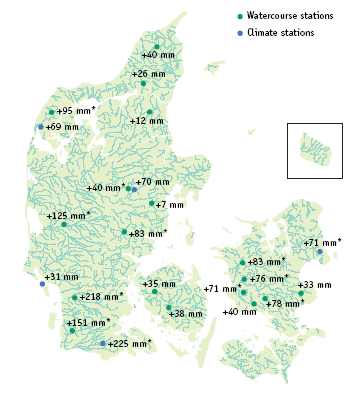
The National Environmental
Research Institute has examined water runoff from watercourses and precipitation (rainfall) in Denmark over the past 85 years. An increase in annual precipitation
has led to an increase in the average runoff from all the watercourses examined.
This close relationship demonstrates that climate changes will have consequences for the future ecological condition of Danish watercourses.
Increases in the annual runoff and annual precipitation have been calculated over a period of 75 years at the 18 watercourse stations (converted to mm) and the five
climate stations. Statistically significant changes (P < 5%) are shown with an asterisk after the figure.
Source: National Environmental
Research Institute
The climate has a great influence on the ecological conditions in and around watercourses. The expected climate changes in Denmark are towards a warmer, wetter, and windier climate
with more storms and more periods of high precipitation. In western Europe, winter precipitation has shown particular increases over the past 100- 200 years. The first effects measured
were changes in the amount and rhythm of water (runoff), and these had already been demonstrated in the last century. Runoff from watercourses is part of the cycle of precipitation,
evaporation, and water catchment. Runoff is unstable, following the same pattern as precipitation.
The study by the National Environmental Research Institute of the trends in runoff and precipitation in Denmark over the past 85 years shows that precipitation in Denmark has been
higher from October to March and lower in the other six months. This means wetter winters and drier summers. So, precipitation has increased in the part of the year where evaporation
is least, and therefore there is a large surplus of rainfall, which mostly becomes surface runoff.
This increases the probability of flooding in the winter months. However, despite the fact that there has generally been less rainfall in the summer months, there has not been less water in
watercourses in these months. This is probably because of the buffer effect in the form of the increased formation of groundwater developing over the winter months and emptying into
watercourses over the summer.
If these changes in precipitation and runoff continue, there will be enormous consequences for drainage conditions in river valleys, leaching and loss of substances, and the ecological
conditions in watercourses, lakes, and fjords. The changes will also impact Denmark's achievement of good ecological quality as required by the EU Water Framework Directive.

River restoration of Skjern Å
Ringkøbing Fjord increased as the self-cleaning process in Skjern Å came to an end, the river receiving nutrients from the surrounding fields and carrying them into the fjord.
For many hundreds of years, the Skjern Å valley and meadows have been an important foundation for the people living along the river. The fertile meadows of the river valley provided
grass for livestock in the summer, and good hay for the winter. Whenever the river flooded, nutrients carried by the river were deposited on the meadows. In this way the river water
was cleaned before running out into Ringkøbing Fjord, and the meadows were fertilised and provided good grazing.
Sometimes, however, the river was unpredictable, and it flooded even in the summer, taking farmers' grass and hay. For this reason, people tried to control the river for hundreds of
years. Dykes were built to prevent flooding in the summer, and irrigation and drainage ditches were dug. However, it was not until the 1960s that the river finally came under control in a
grand project. Skjern Å itself was led into a newly dug, straight course, which channelled the water quickly out into the fjord. The unpredictable river had been tamed. An impressive
piece of engineering which successfully fulfilled its purpose and soon created production dividends in the Skjern Å valley. Cornfields replaced grazing meadows.
The river is restored
Thirty years later, in 1998, the Danish Parliament decided that about half of the meadows that were drained in the 1960s and transformed into arable land should be re-established, and
that Skjern Å should again wind its way through the landscape. Soon after the largest and most expensive restoration project in northern Europe was set in motion. The EU supported
the project financially, as the restoration would create a valuable natural area of international significance. Agriculture would be offered replacement land, as the state would buy land
behind the project area for exchange. Many voluntary agreements were made. Several landowners chose to keep their land in the river valley, however, while the state paid
compensation for lost cultivation opportunities.
The project was completed in 2003. A total of 43km of winding river had been dug and 1.3 million cubic metres of soil had been moved, enough to fill a convoy of trucks stretching
from Skjern in Denmark to the southern Alps.
Now, once again the sun shines over meadows. Birds have taken well to the new natural area. The broad meadows are being grazed by livestock, and offer a welcome to many
meadow birds. The new natural area extends for 2200 hectares and pesticides and artificial fertilizers are banned in the area. This is not only of benefit to the water quality in the river
and the fjord, but it is also good for the natural plant life in the area.
Downside to the project
However, as time went by, it became clear that there was a downside to the project. Plants, animals, and birds that had previously lived in the freshwater meadows disappeared. The
drop in the water level meant that iron compounds came into contact with the oxygen in the air, forming ochre pollution, which in turn impacted life in the watercourse. Pollution in
Source: Danish Forest and Nature Agency
| Front page | | Contents | | Previous | | Next | | Top |
Version 1.0 October 2004, © Danish Environmental Protection Agency
|